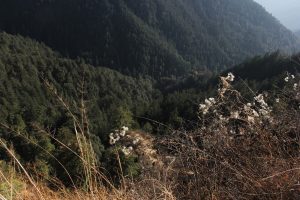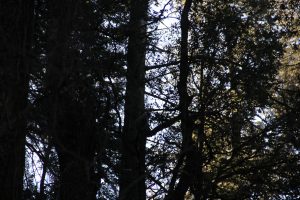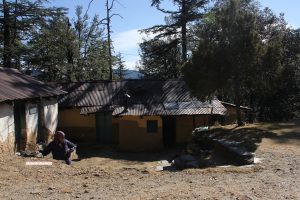Travellers must move on towards the destination, the source of life. There are always halts filled with magic en route, but the journey of the ‘seeker’ makes him plod on and on. While traveling to Gangotri I have taken a night halt at Bhairon Ghati, 9 kms short. Next morn, I leave the Bhairon temple in the care of its tree cluster, the GMVN Tourist Rest House happy in its hollow, and the rigid crags that tower above the place to their permanent positions. They have enacted the role of a protective godfather all through, as if shielding the hamlet from some danger. They have also successfully hidden the pleasures of the journey beyond as if they are a grave finality.

The thought of river Bhagirathi, like a mystical light shining in the distance, led me ahead till Gangotri was reached. Gangotri is a temple town, a holy place for most Indians. It is also the end of pilgrimage for some and the beginning of pilgrimage for others. The height above sea-level is 3140 m and you can feel the sharpness of the wind. Cars and jeeps line the thin metallic road and cops have a tough time organising orderly parking.

The religious significance of the place is immense. It is believed that river Bhagirathi owes its origin to the foot of Lord Vishnu, wherefrom it started flowing first, and was captured by the jatas (hair-locks) of Lord Shiva. That was a tale of heavens above. On earth, King Bhagirath, unable to bear the suffering of his people due to water scarcity worshipped Lord Shiva at Gangotri. His devotion so pleased Lord Shiva that he asked him for a boon. Bhagirath prayed that Ganga be released from Lord Shiva’s hair locks for the benefit of his people. So was granted Ganga to the earth. It is named after Bhagirath as river Bhagirathi from the point of its descent at Gaumukh up to Dev Prayag. At Dev Prayag, the river Alaknanda merges with Bhagirathi and thence onwards it is called Ganga.
An arched gate, gifted by the Border Police to the town, greets the eye. Everyone has to pass through it, the destination being Gangotri, temple, the bathing ghats or the steps leading to the trek route of 18 kilometers to Gaumukh. Gangotri temple is small. It is erected on the sacred stone where as per tradition Bhagirath worshipped Lord Shiva. The building is non-ornamental, rather ordinary in appearance. There are no statues on the exterior and its height is also about 12 feet. E.T. Atkinson wrote of it in the 19th century- “it is quite plain, coloured white with red mouldings, and surmounted with the usual melon-shaped ornament commonly known as Turk’s cap.” The temple is quite the same save that the colour combination is now white walls and silver top.

The serious trekkers take to the steps, which connect the Gangotri ghats and the trek route. Buy a walking stick— you might need three legs on the way ahead. The river Bhagirathi is a pleasant companion all through right up to Gaumukh. Sometimes the mountain rocks to your side echo the forceful holler of rushing waves. Yes the river makes them sing. The snow peaks enveloped forever in a clouded embrace of the Meghdoot (cloud messenger) sit happily above their unsteady glaciers. It is a treat to lift the eyes from a rivulet meeting the river bed; slowly caress first the green cover, then the black, rough and prominent crags; then allow the vision to melt in the snow at upper reaches.

The trekking route is tough, full of uneven stones, even dusty at times. It is a real test for the muscles of the legs. You really get to know more about your own legs than you believed. Tree trunks have been used to bridge rivulets and one has to balance steps lest the boulders in the water have the last laugh. The trek is a story of ascents and descents. You rise again as the path decides to lift itself from the riverbed. It is good to feel the heights. You tend to pause before every new face of a snow peak, which is revealed to you. The edges of the black crags are to be admired. The eyes can feel their razor thin sharpness and also their blunt prominence.

Shacks en route provide plastic comfort to weary travellers. They offer biscuits, potato chips, simple roti-dal (bread and pulses), paranthas (oil-fried bread), and bottled water. Mattresses to recline on are luxury! There are slogans displayed on banners about the ill effects of plastic and non-biodegradable waste. The glacial river must not be polluted with polythene or plastic wrappers. Thanks to these gentle reminders erected by environmentalists, the route is remarkably free of poly-pack litter. Travellers were seen actually heeding the advice and using dustbins.
Bite into something at Chirbasa, 9 kilometer deep, from the origin of the trek at Gangotri. Have some tea with a dash of salt, it will pep you up. The hamlet of Chirbasa is a cluster of pines rushing from the heights in a straight descent to the riverbed. Shacks are perched on space created between boulders on the ridge. This ridge you cross. Do not halt too long lest the legs refuse to lift again. Bhojbasa, 5 kilometres ahead, has to be reached for a night halt. And of course, sunset must be enjoyed at Bhojbasa before you hit the bed.
The flora along the trek route is different and interesting. Ganga Tulsi, a shrub with a heady scent, used as an accompaniment during Hindu worship, and White Jungle Rose, each flower with only four petals, almost line the route.

Yellow wildflowers too have a word to say! Some concerned environmentalist groups are trying level best to not only generate public awareness but also give a green cover to the Himalayas where it is most needed. So we see plantations of Spruce, Silver Fir, Blue Pine and Himalayan Cedar along the way. A little ahead of Chirbasa, some educationists nurse a Bhojpatra nursery. This effort at preserving a threatened specie is laudable. The Bhojpatra Utilis has a distinct white bark and round green leaves. Its botanical name is Betula Utilis. The bark of this tree served as paper for recording ancient Hindu religions texts. I peel some. It is actually as thin as finest quality paper. I keep it as a memento, but it is not enough to write a song!
There are no wild animals to sight save herds of mountain goat and deer. We see one. A goat blessed with a pair of curved horns is perhaps the leader of this herd and his posturing on a rock proudly proclaims it. The coat of the goats blends with the rocks. The black mountains have yellowish-brown traces. So does the goatskin. There are no trees on these hard infertile rocks and shrubs are sparse. How beautifully God has provided them protection by making them look like rocks! You are left wondering?

The sun plays hide and seek on a June afternoon. Clouds drift at will. Sometimes you see a snow mountain half-concealed by clouds and half-visible to the eyes. It is like watching a Venus, thinly clad, sensuous in demeanour, and amorous in the eye, whom you would like to only see and not touch!
The Bhagirathi river continues to sing its song as we continue upstream. It is past 4 p.m. in the evening. Our guide warns of falling stones in a patch ahead. A warning signboard and we smell trouble. True enough it rains stones on the route ahead. We do not carry hard hats. I hide behind a huge boulder clutching the hand of my 10-year old son. Stones keep rolling down. They can break bones or even throw a person deep down towards the riverbed by sheer impact. One has to exercise caution. This phenomenon in the evening is due to harsh winds blowing across. The mountains in this patch are loose stones embedded in mud. So the peculiar rain. It is strange coincidence that this is the 13th kilometer from Gangotri, I observe! We run across carefully finding our steps when the fury if the mountain is spent.
The last leg to trek for the day to Bhojbasa is tougher still. A stream has to be crossed sans a log bridge. You have to place your feet in the bed on firm stones so as to save your shoes from getting wet. My son exclaims aloud—“Tough route, tottering wooden bridges, falling stones, icy wind, quite deadly.” Still he makes the 14 km trek in good seven hours.

Alas my desire of watching the sunset at Bhojbasa is not fulfilled. The clouds just whisked away the sun in a swift move! I have to wait yet another day braving the biting wind on the Bhojbasa ridge. There is a GMVN Tourist Rest House, an Ashram and several shacks, which serve as night shelter. You come back in life to just hoping for basics; a toilet is a luxury.
The Bhojbasa valley is panoramic. It is really huge. Gaumukh is seen as a cluster of rocks from this ridge. It is the source of the river Bhagrathi or Ganga, regarded by Indians over the centuries as mystical, spiritual and holy. Three peaks of Mount Bhagirathi tower above Gaumukh. It is an unbelievable sight—one, which you deserve in a lifetime. The three summits, Bhagirathi I, II & III perhaps symbolise the trinity of beauty, truth and peace, which I presumed was exposed earlier to me on the trek. How wonderful!

The morning was proclaimed in a loud exclamation. The moon had not left its rightful reign of the night sky and the sun was raising expectations of travellers as it continued in its upward stride. Pure magic was being played all around Bhojbasa Valley by the Great God. Straight above Gaumukh, the cloud curtain was gradually being lifted from over the three Bhagirathi peaks. They were being revealed like sacred verses are spoken to listeners. If you lose them in that pure moment they are gone, sucked in by that force, which transforms the present into the past—the churning wheel of time.

Sure enough an overpowering cloud fall barred the snow peaks from sight in the next few minutes. So were gone two beautiful virginal peaks to our left, one, which was bravely trying to cradle the moon in its last sojourn! The sheer transience of the scene was mesmerising, just like elemental man-woman associations, which charm you as long as they last.

The last 4 kilometers to Gaumukh are tougher. Especially the very last! The trek reduces to nothing but trapeze walk over accumulated boulders. Only faith and will power can take you ahead. Finally Gaumukh, 4000 m above sea-level, is reached. I find a perch on a rock before the cave, the source, and settle down to my thoughts. As I look at Gaumukh, I feel the sensuousness and abundance of love. That love, which knows no bounds. That love, that gives and gives always and forever.

Gaumukh is a cave surrounded by glacial bottle-green ice. Water, the source and preserver of all life on earth, keeps gushing out in good measure. The spectacle is akin to a mother giving birth to a child. The half-moon cave is the source, the water life at birth. And you son of man, a part of this beautiful creation!

People bathe, pray here. By doing so they believe that they have purged all sins. I feel the icy water and look at the slab of ice bobbling beside the rock I sit upon. I look again at Gaumukh or the cow’s mouth, the name given to the glacier cavern. Next moment, I am in the water, my hands clutching a rock and my lungs holding my breath. I have done it! Yes how many get the opportunity to worship the mother source of a holy river at its hideout deep into the Himalayas. The sun is benevolent. It lights up eyes and many lives. The ice sparkles. Sometimes chunks of ice fall down from the top of the glacier cave to meet the water below. Huge blocks of ice and the current of water play a game with each other. The stream cuts into the blocks and pushes it mid-stream. The block tries hard to stay put on its temporary throne and breaks the current into two. The game continues here in a hitherto unusual unseen mirth of ice and water; both same and yet so different!
Above Gaumukh is Tapovan. All saffron clad barefoot or slipper-sporting sadhus (holy men) are headed for that territory. It is place across the Bhagirathi glacier where Rishis and Munis did penance and meditated. Today there is some alarming news from Tapovan. One traveller slipped and fell some distance below to hurt his head on a rock. He was evacuated on a makeshift stretcher by locals and some foreign trekkers. It will be almost ten hours before he reaches Gangotri, where first-aid is available. Bhojbasa, I think, demands a doctor, a medical unit and telephone connectivity for evacuation by helicopter in dire emergencies.

The Himalayan glaciers have long fascinated the British explorers who arduously mapped and recorded their uniqueness. Colonel Gordon (Roof of the World, 17) writes—“the glaciers of the Western Himalayas are twice as extensive as those of the Alps, and are probably the largest in the world or at all events larger than any others out of the polar regions.” How do you recognise a glacier and the river it has given birth, must be understood. I am tempted to quote Lieutenant R. Strachey on the appearance of a glacier—“It seems to be a vast rounded mass of rocks and ground utterly devoid of any sign of vegetation, standing up out of a grassy valley. From the foot of its nearer extremity the river, even here infordable, rushes in a turbid torrent out of a sort of cave; the top of which is but a few feet above the surface of the water. Behind this, the glacier rises less steeply like a bare gravel hill, to its full height, which is probably 500 feet above the water of the river when it leaves the cave.”
After a tete a tete with Bhagirathi glacier and river source one must return to Bhojbasa or if possible Chirbasa for a night halt. Walking early morn on return is pure satisfaction to the visual and olfactory senses. Start about 6–6.30 a.m. The clouds are still lazing in the valley. Their effortless glide up the mountains is inspiring. The atmosphere is filled with the fragrance of plants and shrubs, especially Ganga Tulsi. You become part of generous nature. Many prayers come to lips in such circumstance—God make me a mountain stream so that I can quench the thirst of earth, plants, and men; God make me a wildflower, so that I can enliven a jungle path; God make me a birdsong so that I fill the woods with music; God make me a cloud so that I roam anywhere at free will; God make me a mountain summit so that I tower above everything else; God make me the wind so that I can give life to the world; God make me a star in the sky so that I fill the eyes of your children with dreams. Any one of these prayers could be yours. The prayer of humility, of freedom, of power, or dreams; it just depends how you feel. I, for one, would like to end up as a birdsong in a forest!
All good things these days end up in a mix of concrete, machine and artificiality. Should you come here once, you would be happy that for some days you were only a child of benevolent Nature.
Please follow and like us:






















































































